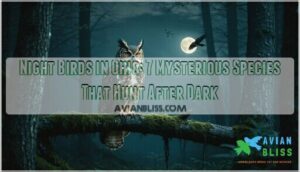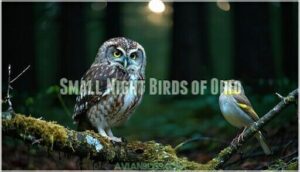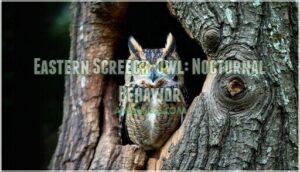This site is supported by our readers. We may earn a commission, at no cost to you, if you purchase through links.

Great Horned Owls hunt with silent precision, while Eastern Screech-Owls trill from backyard trees.
Common Nighthawks dive dramatically above city lights, creating distinctive booming sounds with their wings.
Chuck-will’s-widows call repeatedly from dense forests, and Eastern Whip-poor-wills can repeat their name over 1,000 times nightly.
Barred Owls provide the classic "who-cooks-for-you" call near wetlands, and Northern Saw-whet Owls offer soft tooting sounds in wooded areas.
These nocturnal hunters control insect and rodent populations while creating Ohio’s nighttime soundscape.
Each species has unique hunting strategies and vocal patterns that reveal their hidden world, making them a crucial part of Ohio’s nighttime soundscape with their silent precision.
Table Of Contents
- Key Takeaways
- Nocturnal Birds in Ohio
- Species With Active Night Behaviors
- Common Nighthawk: Calls and Habits
- Chuck-will’s-widow: Nighttime Characteristics
- Eastern Whip-poor-will Ecological Role
- Nightjars in Ohio’s Ecosystem
- Small Night Birds of Ohio
- Nighttime Singers in Ohio
- Owl Diversity in Ohio
- Conservation Efforts for Ohio’s Night Birds
- Frequently Asked Questions (FAQs)
- What birds fly at night in Ohio?
- What Ohio bird sings at night?
- What kind of birds come out at night time?
- Which bird will come out at night?
- What kind of birds make noise at night?
- Which bird is very active at night?
- Are there nightjars in Ohio?
- What little birds come out at night?
- How do urban environments affect night bird populations?
- Whats the best time to observe nocturnal birds?
- Conclusion
Key Takeaways
- You’ll encounter seven primary night bird species in Ohio including Great Horned Owls, Eastern Screech-Owls, Common Nighthawks, Chuck-will’s-widows, Eastern Whip-poor-wills, Barred Owls, and Northern Saw-whet Owls, each with distinct calls and hunting strategies.
- These nocturnal birds control Ohio’s insect and rodent populations while creating the state’s nighttime soundscape, with some species like Eastern Whip-poor-wills repeating their calls over 1,000 times nightly.
- You can best observe these night birds during dawn and dusk when they’re most active, or listen between midnight and 4 AM when species like Northern Mockingbirds sing loudest during breeding season.
- Ohio’s night bird populations face conservation challenges from habitat loss, light pollution, and declining insect populations, with some species like the Eastern Whip-poor-will experiencing a 70% population decline since the 1960s.
Nocturnal Birds in Ohio
When Ohio’s daylight fades, a hidden world awakens as nocturnal birds emerge from their daytime hiding spots.
In Ohio’s darkness, thirteen remarkable night birds reveal nature’s most secretive hunters.
These night birds ohio have evolved remarkable nocturnal adaptations that let them thrive in darkness while most other birds sleep.
You’ll discover thirteen distinct species calling Ohio ecosystems home, from tiny screech-owls to powerful great horned owls.
These avian predators use specialized hearing and vision to hunt insects, small mammals, and fish during nighttime hours.
Owl species ohio dominate the nocturnal landscape, but nightjars and herons also play vital roles.
Bird migration patterns bring seasonal visitors like chuck-will’s-widows and common nighthawks to Ohio’s forests and fields.
Unfortunately, habitat loss threatens many of these mysterious creatures.
Learning ohio birds identification techniques helps you recognize their distinctive calls echoing through the darkness.
Understanding ohio owl calls and other nocturnal vocalizations opens doors to a fascinating world that most people never experience.
These night hunters maintain ecological balance while creating an enchanting soundscape.
Species With Active Night Behaviors
When darkness falls across Ohio’s landscapes, a hidden world comes alive with remarkable nocturnal birds ohio species.
These night hunters possess extraordinary Nocturnal Adaptations that transform them into skilled predators. You’ll discover that each species has developed unique Hunting Strategies perfectly suited to their nighttime lifestyle.
Understanding these mysterious creatures requires recognizing their distinct behavioral patterns:
- Breeding Seasons drive intense nighttime vocalizations as males establish territories
- Habitat Preferences range from dense woodlands to open farmlands and urban areas
- Migration Patterns bring seasonal visitors from distant wintering grounds
- Specialized feeding behaviors target specific prey during peak activity hours
Night birds like owls, nightjars, and herons have evolved remarkable sensory abilities. Their enhanced hearing, silent flight, and exceptional night vision make them formidable hunters in Ohio’s diverse ecosystems.
Common Nighthawk: Calls and Habits
You’ll recognize the Common Nighthawk by its sharp "peent" call piercing Ohio’s twilight air.
These aerial acrobatics masters perform stunning dives, creating a distinctive "boom" when air rushes through their wingtips during courtship displays.
Nighthawk identification becomes easier once you spot their white wing patches and erratic flight patterns while hunting insects.
Their insectivore diet consists entirely of flying prey caught during nighttime vocalizations sessions.
Roosting behavior involves resting on flat surfaces like gravel rooftops, where their camouflage makes them nearly invisible among Ohio’s diverse nocturnal birds.
These birds are part of the nightjar or goatsucker family.
Chuck-will’s-widow: Nighttime Characteristics
How does the Chuck-will’s-widow become nearly invisible during daylight hours? This remarkable nightjar showcases nature’s perfect camouflage with its mottled brown plumage that mimics tree bark seamlessly.
Unlike the Common Nighthawk or Eastern Whippoorwill, this species demonstrates unique nighttime characteristics that set it apart among nightjars.
During Breeding Season, you’ll discover four fascinating nocturnal behaviors:
- Habitat Preference: Perches horizontally on branches in dry woodlands, resembling broken twigs
- Camouflage mastery: Remains motionless during day, relying on cryptic coloration for protection
- Insect Diet hunting: Uses its exceptionally wide mouth to capture flying insects mid-flight
- Nocturnal Calls: Produces loud "chuck-will’s-widow" nighttime vocalizations that echo through southeastern forests
These adaptations make the Chuckwillswidow one of Ohio’s most elusive nocturnal hunters.
The species faces threats, including habitat fragmentation, contributing to population decline.
Eastern Whip-poor-will Ecological Role
Every night, the Eastern Whippoorwill emerges as one of Ohio’s most effective nocturnal predators, playing a pivotal ecological role that extends far beyond its haunting three-syllable call.
This remarkable nightjar specializes in insect population control, consuming thousands of moths, beetles, and flying insects each breeding season. You’ll find these nocturnal birds demonstrate remarkable habitat specificity, requiring structurally diverse forests with open understories for ideal hunting success.
Their breeding success directly correlates with insect abundance, making them excellent indicators of ecosystem health. During migration patterns, Eastern Whippoorwills time their movements precisely with peak insect emergence, showcasing their evolutionary adaptation to nocturnal predation cycles.
As forest-dwelling specialists, they’ve experienced a concerning 70% population decline since the 1960s, earning Near Threatened status from conservation organizations.
When you hear their distinctive calls echoing through Ohio’s woodlands, you’re witnessing a critical component of the state’s nocturnal ecosystem at work, maintaining the delicate balance between predator and prey.
Nightjars in Ohio’s Ecosystem
Ohio’s nightjar family serves as nature’s nighttime pest control squad.
These nocturnal birds—including the Common Nighthawk, Chuck-will’s-widow, and Eastern Whip-poor-will—excel at insect control, consuming thousands of moths, beetles, and mosquitoes nightly.
Their nightjar diet consists entirely of flying insects captured with wide-gaping mouths and specialized bristles.
These night birds have specific habitat needs, preferring open woodlands, forest edges, and surprisingly, urban areas where they nest on gravel rooftops.
Nightjars demonstrate remarkable migration patterns, forming large flocks that travel thousands of miles to Central and South America each autumn.
Unfortunately, population threats are mounting.
Habitat loss, light pollution, and declining insect populations have caused significant declines across Ohio.
The Eastern Whip-poor-will has experienced a 75% population drop over five decades.
Conservation efforts focus on preserving their essential breeding and foraging habitats throughout the state.
Small Night Birds of Ohio
Beyond the well-known nightjars, Ohio’s darkness reveals a fascinating collection of tiny predators that excel at nocturnal birds hunting.
These compact hunters include the Yellow-breasted Chat, whose distinctive bird calls echo through thickets as it searches for insects and berries.
You’ll discover urban owls like the Northern Saw-whet Owl, Ohio’s smallest owl species, whose high-pitched toots create unmistakable ohio bird sounds for bird identification.
The secretive Long-eared Owl uses silent flight to capture small rodents, while Short-eared Owls patrol open grasslands.
Each species has specific habitat needs – from wetland edges to forest clearings.
Their nesting habits vary dramatically, with some preferring tree cavities while others nest on the ground.
These small night birds provide essential insect control, consuming thousands of moths, beetles, and flying insects annually.
Understanding their bird sounds and behaviors helps you appreciate Ohio’s hidden nocturnal ecosystem while supporting conservation efforts that protect their increasingly fragmented habitats.
Nighttime Singers in Ohio
Nature’s symphony doesn’t end when the sun sets—it transforms into something entirely different.
Ohio’s night singers create a complex tapestry of nocturnal vocalizations that’ll change how you experience evenings outdoors.
You’ll discover birds active at night throughout Ohio’s diverse songbird habitats.
Northern Mockingbirds release their impressive repertoires between midnight and 4 AM, while Yellow-breasted Chats chirp their distinctive mating songs from dense thickets.
These urban singers have adapted remarkably well to city environments, turning parks and backyards into concert halls.
Listen for the haunting calls of nocturnal birds like migrating thrushes and buntings passing overhead during spring and fall.
Their ohio bird sounds serve as acoustic landmarks in the darkness, helping you identify species you might never see.
These night birds aren’t just entertaining—they’re essential indicators of ecosystem health.
Their conservation status often reflects habitat quality and environmental changes.
Learning to recognize these nighttime voices connects you to Ohio’s hidden avian world while supporting citizen science efforts that help protect these remarkable singers.
Owl Diversity in Ohio
You’ll find eleven distinct owl species calling Ohio home, ranging from the tiny Northern Saw-whet Owl at just seven inches to the impressive Great Horned Owl with its four-foot wingspan.
These silent hunters have adapted to thrive in environments from dense forests to open farmlands, using their exceptional night vision and specialized feathers to control rodent populations across the state, which is a key factor in maintaining the ecological balance of Ohio’s environments.
Great Horned Owl: Vocalizations
When darkness falls across Ohio, you’ll hear the great horned owl‘s commanding presence through its deep, gravelly hoots.
These powerful vocalizations serve as both territory defense mechanisms and mating calls, showcasing an impressive vocal range that includes barks, shrieks, and spine-chilling screams.
To further explore this topic, consider the range of available products.
Key vocalization features:
- Four to five distinct hooting notes in territorial calls
- Higher-pitched female hoots compared to males
- Complex acoustic adaptations for nighttime communication
Eastern Screech-Owl: Nocturnal Behavior
Unlike Great Horned Owls’ booming calls, Eastern Screech-Owls whisper through Ohio’s nights with subtle tremolos.
These nocturnal birds excel at Urban Adaptations, thriving in backyards and parks.
Their Silent Flight and exceptional Sensory Perception make them deadly hunters of insects and small rodents.
Nesting Habits include tree cavities where they raise young.
Among Ohio birds, this owl species demonstrates remarkable Hunting Strategies and nocturnal behavior adaptations.
They share habitats with year-round resident birds.
Conservation Efforts for Ohio’s Night Birds
While Ohio’s owls represent remarkable nocturnal diversity, protecting these mysterious hunters requires dedicated bird conservation efforts. Ohio conservation efforts focus on thorough strategies that you can support in your community.
Habitat restoration projects recreate essential nesting environments, while pesticide reduction programs protect insect food sources that night birds depend upon. Nest box programs provide artificial homes for species like Eastern Screech-Owls when natural cavities become scarce.
- Reducing light pollution helps migrating birds navigate safely through urban areas
- Citizen science projects allow volunteers to monitor nocturnal bird populations across Ohio
Supporting Ohio bird conservation can be done through various avenues. These wildlife conservation initiatives guarantee future generations will hear nighttime calls echoing through Ohio’s landscapes.
Frequently Asked Questions (FAQs)
What birds fly at night in Ohio?
Thirteen distinct nocturnal species call Ohio home.
You’ll encounter owls like Great Horned and Screech varieties, nightjars including Whip-poor-wills and Common Nighthawks, plus Night-Herons and singing Mockingbirds hunting insects after sunset, which includes singing Mockingbirds.
What Ohio bird sings at night?
You’ll hear Northern Mockingbirds singing melodiously at night, especially young males between midnight and 4 AM.
Yellow-breasted Chats also chirp after dark during summer, while Eastern Whip-poor-wills repeat their distinctive three-syllable calls.
What kind of birds come out at night time?
When darkness falls, you’ll discover owls, nightjars, herons, and some songbirds emerge to hunt and sing.
These nocturnal species include Great Horned Owls, Eastern Whip-poor-wills, Common Nighthawks, and Northern Mockingbirds actively foraging after sunset, which showcases their unique ability to thrive in the darkness.
Which bird will come out at night?
You’ll encounter owls like Great Horned and Barn Owls, nightjars including Eastern Whip-poor-wills, and songbirds such as Northern Mockingbirds.
These nocturnal species emerge after sunset to hunt insects, attract mates, and forage throughout Ohio’s diverse habitats.
What kind of birds make noise at night?
Ohio’s nocturnal symphony features owls hooting their territorial calls, nightjars like whip-poor-wills repeating their namesake songs, mockingbirds whistling melodies, and night-herons emitting distinctive barks near wetlands throughout the evening hours.
Which bird is very active at night?
Several owl species are extremely active at night, including Great Horned Owls and Eastern Screech-Owls.
You’ll also find nightjars like Common Nighthawks hunting insects after dark, using their silent flight to catch prey.
Are there nightjars in Ohio?
Yes, you’ll find three nightjar species in Ohio: Common Nighthawk, Chuck-will’s-widow, and Eastern Whip-poor-will.
These summer visitors hunt flying insects at dusk and dawn, using their wide mouths and silent flight patterns.
What little birds come out at night?
You’ll find Eastern Screech-Owls, Northern Saw-whet Owls, and young Northern Mockingbirds active after dark.
These small nocturnal birds hunt insects, sing for mates, and navigate Ohio’s nights with specialized adaptations for darkness.
How do urban environments affect night bird populations?
Urban environments can disrupt your local night birds through light pollution, habitat fragmentation, and building collisions. However, adaptable species like Eastern Screech-Owls and Northern Mockingbirds often thrive in cities.
Whats the best time to observe nocturnal birds?
You’ll have the best luck spotting nocturnal birds during dawn and dusk when they’re most active.
Try listening around midnight to 4 AM when mockingbirds sing loudest, or venture out during breeding season for maximum activity.
Conclusion
Picture yourself stepping outside on a warm Ohio evening, listening carefully as darkness settles around you.
The night birds in Ohio create a symphony that’s been playing for centuries, from the Great Horned Owl’s deep hoots to the Chuck-will’s-widow’s repetitive calls.
You’ll discover these seven species transform ordinary nights into extraordinary wildlife experiences, and next time you hear mysterious calls after sunset, you’ll know exactly which nocturnal hunters are sharing their ancient songs with you.
- https://globalbirdinginitiative.org/bird-identification/species-by-location/ohio-us/night-birds-in-ohio/
- https://ohiobirds.org/bird-conservation/bird-conservation-in-ohio/
- https://birdsinthetree.com/birds-of-ohio/
- https://theworldsrarestbirds.com/birds/owls-in-ohio/
- https://roamingbirds.com/owls-in-ohio/












